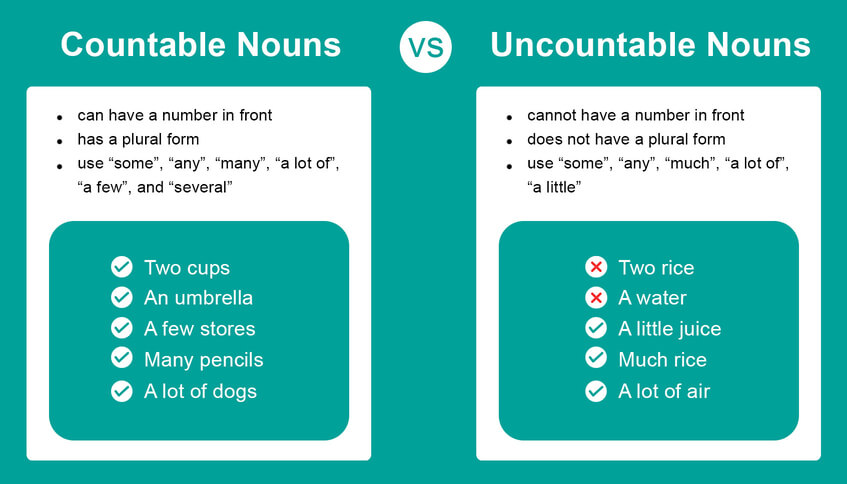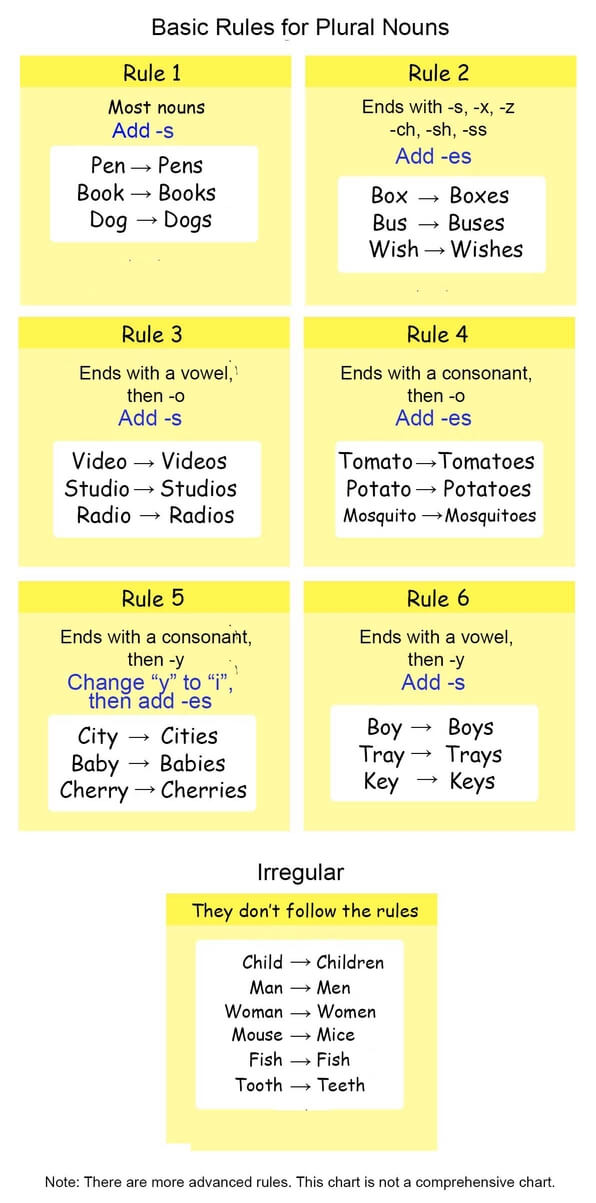Countable and Uncountable Nouns
- There are 2 types of nouns in English: countable and uncountable.
- Countable nouns can be counted (1 apple, 2 apples), uncountable nouns cannot (water, music).
- To make a noun plural, add 's' to the end of the word.
- For nouns that end in 's', 'x', 'sh', 'ch', or 'z', add 'es' at the end to make it plural.
- If 'y' is preceded by a consonant, replace 'y' with 'ies'. If 'y' is preceded by a vowel, just add 's'.
- Remember that some nouns are irregular and do not follow these rules.
- "A" and "an" are used before countable, singular nouns.
- Use "a" before words that begin with a consonant sound and "an" before words that begin with a vowel sound.
- If a word starts with a vowel that makes a consonant sound, use "a". (E.g. "a university")
- If a word starts with a consonant that makes a vowel sound, use "an". (E.g. "an hour")
Countable and Uncountable Nouns
A noun is a word used to name a person, place, thing, or idea. There are two types of nouns: countable and uncountable. Countable nouns are items that you can count. For example, you can have 1 apple, 2 apples, or many apples. Uncountable nouns are items that you cannot count. For example, water, music, and love. You cannot have 2 waters, 3 musics, or many loves.

Examples:
-
There are six apples on the table.
This is an example of using a countable noun.
-
There is water.
In this sentence, water is an uncountable noun. It cannot be counted (You cannot say 1 water, 2 waters ...)
-
WRONG: There are 2 waters.
Water is uncountable. 'Waters" is WRONG. Don't put a number (1, 2, 3, etc) or an article (a or an) in front of an uncountable noun.
How to Form Plural Nouns
Singular Form: When there is only 1 thing, we use the singular form of a noun. 1 book, 1 cake, 1 computer, and so on. ('book', 'cake', and 'computer' are singular forms of the noun.)
When we have more than one thing, we use the plural form. Examples: 'books', 'cakes', 'computers'
Usually, we just add an "s" at the end of the word to make a plural form. However, there are other rules as well.

Rule 1: Add 's' to the end of the word
Examples:
-
dog -> dogs
We added 's' to the end of 'dog'.
-
pen -> pens
We added 's' to the end of 'pen'.
Rule 2: Add 'es' to the end of the word
Some nouns don't follow the Rule 1. For nouns that end in 's', 'x', 'sh', 'ch', or 'z', we add 'es' at the end to make it plural.
Examples:
-
bus -> buses
We added 'es' to the end of 'bus'.
-
box -> boxes
We added 'es' to the end of 'box'.
Rule 3: Replace 'y' with 'ies' or Add 's'
Nouns that end in 'y' have another rule. If 'y' is preceded by a consonant, we replace 'y' with 'ies'. But if 'y' is preceded by a vowel, we just add 's'.
Examples:
-
country -> countries
We replaced 'y' with 'ies' because 'y' is preceded by a consonant 'r'.
-
family -> families
We replaced 'y' with 'ies' because 'y' is preceded by a consonant 'l'.
-
day -> days
We added 's' to the end of 'day' because 'y' is preceded by a vowel 'a'.
-
journey -> journeys
We added 's' to the end of 'journey' because 'y' is preceded by a vowel 'e.
Irregular Nouns
Take note that some nouns are irregular and do not follow these rules. For example, 'child' becomes 'children', and 'goose' becomes 'geese'.
Examples:
-
child -> children
-
goose -> geese
-
tooth -> teeth
-
woman -> women
-
man -> men
-
mouse -> mice
-
cactus -> cacti
-
foot -> feet
-
fish -> fish
-
knife -> knives

The Articles "A" and "An"
"A" and "an" are articles in English. They are used before countable, singular nouns. Use "a" before words that begin with a consonant sound, and "an" before words that begin with a vowel sound.
Basically, "a" and "an" mean "1" in English.

Examples:
-
He has a cat.
The word "cat" begins with a consonant sound, so "a" is used.
-
I ate a hamburger.
The word "hamburger" begins with a consonant sound, so "a" is used.
-
She is an engineer.
The word "engineer" begins with a vowel sound, so "an" is used.
-
There is an apple.
The word "apple" begins with a vowel sound, so "an" is used.
Exceptions to the Rule
If the word starts with a vowel but the vowel makes a sound like a consonant, we should use "a".
If the word starts with a consonant but makes a sound like a vowel, we should use "an".
Examples:
-
Frank is a university student.
Here "university" starts with 'u,' a vowel, but it makes a 'juː' sound which is similar to 'y,' a consonant. Hence "a" is used.
-
She is an honest person.
Though "honest" starts with 'h,' a consonant, the 'h' is silent, so the first sound we hear is 'o,' a vowel. Hence, "an" is used.
We typically practice this rule and its exceptions by listening and repeating sentences. Over time, we'll get used to saying the correct one without having to think about it!
和AI英语老师一起练习这个话题
AI英语老师会教您语法,并以对话的形式和您一起练习。 另外,还有 100 多个有关该主题的练习题来巩固您的理解。
在您的手机或平板电脑上免费试用 ALULA








你对这节课有任何问题吗?请在下面的评论区提问。